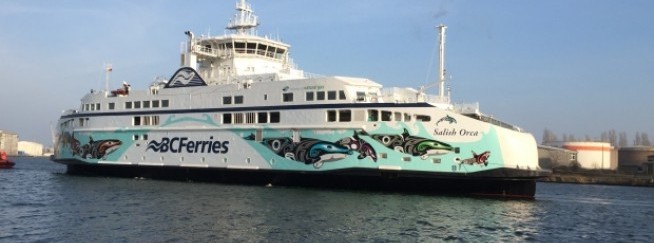Shipyards and province eager to build ferries in B.C.
Source: Times Colonist
Author: Carla Wilson
Published Date: Aug 18, 2017
The president of the Shipyard General Workers’ Federation is hopeful after hearing that provincial Transportation Minister Claire Trevena favours B.C. Ferries having its vessels built at home in coastal shipyards.
“I think it is absolutely fantastic news for the industry,” George MacPherson said Thursday.
Negotiations are being planned next month to help map the best way to make it happen, he said.
From the early days of B.C.’s ferry system through to the 1990s, B.C. Ferries would come to industry to describe what it wanted to do and look for ideas on how to make that happen, MacPherson said. “Everybody would get in a room and they’d figure it out,” he said.
“We are not looking for subsidies. We are just looking for a fair and level playing field. That’s all the industry has ever asked for.”
The new NDP government has said it would allow B.C. yards to bid competitively on new ferry projects. “They say they are very eager to work with me to ensure that we can have B.C. shipyards building B.C. ferries,” Trevena said this week,
MacPherson recalled planning for B.C.’s two Spirit-class ferries, saying then-B.C. Ferries president Frank Rhodes gathered shipyard and union representatives together. “Frank just laid it out: Here’s what we want to build and how are we going to do it. And the industry just came together and put a package together that made it work,” MacPherson said.
A consortium of Victoria Shipyards, Allied Shipbuilders of North Vancouver and Vito Shipyard in Delta worked well together, he said. “Everybody made some money, the job was on time, on budget.”
The Spirit of British Columbia and the Spirit of Vancouver Island came into service in the early 1990s. Those vessels will go to Poland for mid-life refits — the first time that B.C. Ferries has sent vessels offshore for a refit.
B.C. Ferries said the $140-million job is “massive” and more than a basic refit. The ships will be converted to run on liquefied natural gas as well as diesel. Safety features and passenger areas will get major upgrading. MacPherson said the work “could have easily been done here.”
As for the task of LNG conversion, he said: “How do you get experience? Go do the job.”
The Seaspan shipyard in North Vancouver was shortlisted for the contract, but pulled out because its yards were too busy. Seaspan is constructing non-combat ships for the federal government.
B.C.’s shipbuilding sector weathered years of ups and downs, leading some to close. As work dried up, yards lost capacity and expertise.
Optimism returned in 2011 when Seaspan, owner of Vancouver and Victoria shipyards, won the right to negotiate $8 billion worth of contracts to build federal non-combat ships. Three ships are under construction in North Vancouver. The contracts renewed confidence in the sector, led to hundreds of millions of dollars in private infrastructure investment, saw colleges and universities ramp up marine training and bolstered businesses serving the sector. MacPherson estimates that today B.C. shipyards employ about 2,000 workers.
For decades, B.C. Ferries vessels were mostly built in Victoria or Vancouver, but recent contracts have largely gone to European yards. “We have allowed a whole lot of work to leave that shouldn’t have left,” MacPherson said.
Offshore yards are often heavily subsidized by government, and may not have the wages or working conditions to the standard seen in B.C., making competition more difficult, he said.



Site design by Ravensfoot